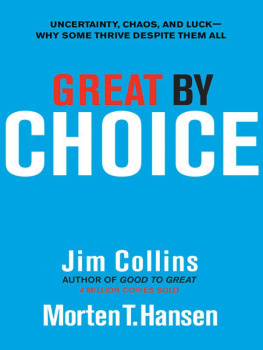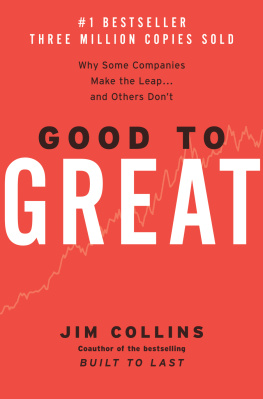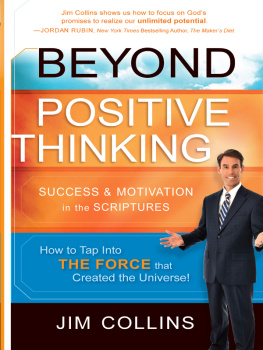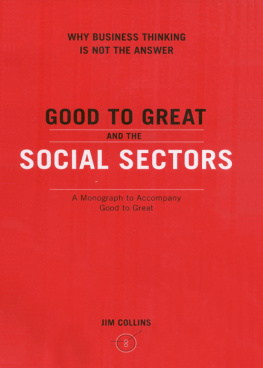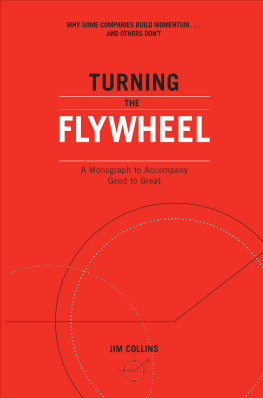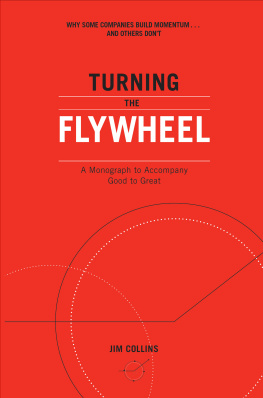Morten T. Hansen
FROM JIM:
To my grandmother Delores,
who at age 97 still had big dreams and audacious goals.
FROM MORTEN:
To my daughters, Alexandra and Julia,
whose generation will create the future.
Contents
We simply do not know what the future holds.
Peter L. Bernstein
W e cannot predict the future. But we can create it.
Think back to 15 years ago, and consider whats happened since, the destabilizing eventsin the world, in your country, in the markets, in your work, in your lifethat defied all expectations. We can be astonished, confounded, shocked, stunned, delighted, or terrified, but rarely prescient. None of us can predict with certainty the twists and turns our lives will take. Life is uncertain, the future unknown. This is neither good nor bad. It just is , like gravity. Yet the task remains: how to master our own fate, even so.
We began the nine-year research project behind this book in 2002, when America awoke from its false sense of stability, safety, and wealth entitlement. The long-running bull market crashed. The government budget surplus flipped back to deficits. The terrorist attacks of September 11, 2001, horrified and enraged people everywhere; and war followed. Meanwhile, throughout the world, technological change and global competition continued their relentless, disruptive march.
All of this led us to a simple question: Why do some companies thrive in uncertainty, even chaos, and others do not? When buffeted by tumultuous events, when hit by big, fast-moving forces that we can neither predict nor control, what distinguishes those who perform exceptionally well from those who underperform or worse?
We dont choose study questions. They choose us. Sometimes one of the questions just grabs us around the throat and growls, Im not going to release my grip and let you breathe until you answer me! This study grabbed us because of our own persistent angst and gnawing sense of vulnerability in a world that feels increasingly disordered. The question wasnt just intellectually interesting but personally relevant. And as we spent time with our students and worked with leaders in both the business and social sectors, we sensed the same angst in them. In the intervening years, events have served only to reinforce this sense of unease. Whats coming next? All we know is that no one knows.
Yet some companies and leaders navigate this type of world exceptionally well. They dont merely react; they create. They dont merely survive; they prevail. They dont merely succeed; they thrive. They build great enterprises that can endure. We do not believe that chaos, uncertainty, and instability are good; companies, leaders, organizations, and societies do not thrive on chaos. But they can thrive in chaos.
To get at the question of how, we set out to find companies that started from a position of vulnerability, rose to become great companies with spectacular performance, and did so in unstable environments characterized by big forces, out of their control, fast moving, uncertain, and potentially harmful. We then compared these companies to a control group of companies that failed to become great in the same extreme environments, using the contrast between winners and also-rans to uncover the distinguishing factors that allow some to thrive in uncertainty.
We labeled our high-performing study cases with the moniker 10X because they didnt merely get by or just become successful. They truly thrived. Every 10X case beat its industry index by at least 10 times . If you invested $10,000 in a portfolio of the 10X companies at the end of 1972 (holding each enterprise at the general stock market rate of return until it came online on the New York Stock Exchange, the American Stock Exchange, or NASDAQ), your investment would have grown to be worth more than $6 million by the end of our study era (through 2002), a performance 32 times better than the general stock market.
To grasp the essence of our study, consider one 10X case, Southwest Airlines. Just think of everything that slammed the airline industry from 1972 to 2002: Fuel shocks. Deregulation. Labor strife. Air-traffic-controller strikes. Crippling recessions. Interest-rate spikes. Hijackings. Bankruptcy after bankruptcy after bankruptcy. And in 2001, the terrorist attacks of September 11. And yet if youd invested $10,000 in Southwest Airlines on December 31, 1972 (when it was just a tiny little outfit with three airplanes, barely reaching break-even and besieged by larger airlines out to kill the fledgling) your $10,000 would have grown to nearly $12 million by the end of 2002, a return 63 times better than the general stock market. Its a better performance than Wal-Mart, better than Intel, better than GE, better than Johnson & Johnson, better than Walt Disney. In fact, according to an analysis by Money Magazine , Southwest Airlines produced the #1 return to investors of all S&P 500 companies that were publicly traded in 1972 and held for a full 30 years to 2002. These are impressive results by any measure, but theyre astonishing when you take into account the roiling storms, destabilizing shocks, and chronic uncertainty of Southwests environment.
Why did Southwest overcome the odds? What did it do to master its own fate? And how did it accomplish its world-beating performance when other airlines did not? Specifically, why did Southwest become great in such an extreme environment while its direct comparison, Pacific Southwest Airlines (PSA), flailed and was rendered irrelevant, despite having the same business model in the same industry with the same opportunity to become great? This single contrast captures the essence of our research question.
Weve been asked by many of our students and readers, How is this study different from your previous research into great companies, especially Built to Last and Good to Great ? The method is similar (comparative historical analysis) and the question of greatness is constant. But in this study, unlike any of the previous research, we selected cases not just on performance or stature but also on the extremity of the environment .
We selected on performance plus environment for two reasons. First, we believe the future will remain unpredictable and the world unstable for the rest of our lives, and we wanted to understand the factors that distinguish great organizations, those that prevail against extreme odds, in such environments. Second, by looking at the best companies and their leaders in extreme environments, we gain insights that might otherwise remain hidden when studying leaders in more tranquil settings. Imagine being on a leisurely hike, wandering along warm, sunlit meadows, and your companion is a great mountaineer who has led expeditions up the most treacherous peaks in the world. Youd probably notice that hes a little different from others, perhaps more watchful of the trail or more careful in packing his small daypack. But overall, given the safe predictability of a glorious spring day, it would be hard to see what really makes this leader so exceptional. Now, in contrast, envision yourself on the side of Mount Everest with this same climber, racing a murderous storm. In that environment, youd see much more clearly what makes him different and what makes him great.
Studying leaders in an extreme environment is like conducting a behavioral-science experiment or using a laboratory centrifuge: throw leaders into an extreme environment, and it will separate the stark differences between greatness and mediocrity. Our study looks at how the truly great differed from the merely good in environments that exposed and amplified those differences. |

